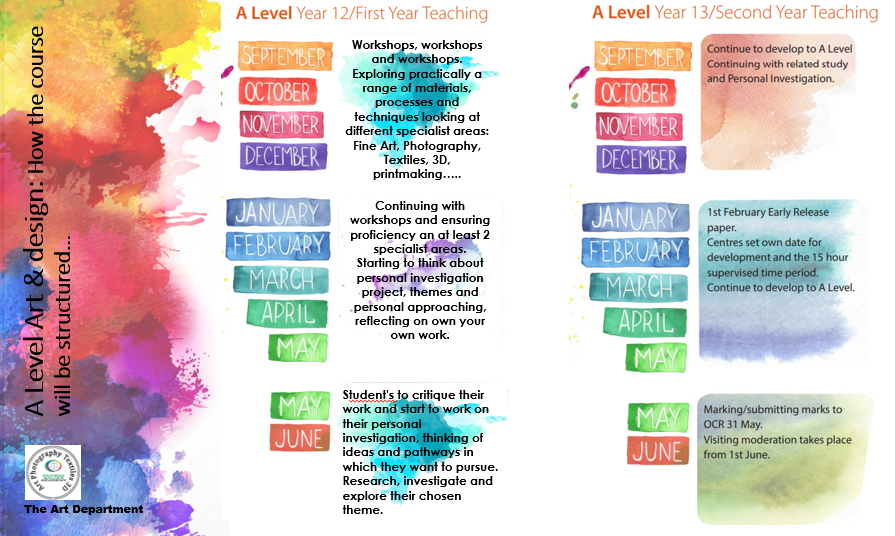Applied Art & Design (A Level)
GCE A LEVEL
Introduction to Course
At KS5, we offer A Level Fine Art, A Level Photography and A Level Textiles- a natural progression from GCSE and the chosen area in which pupils have specialised in- Fine Art, Photography and Textiles.
The course delivered is OCR Art & Design: Fine Art (H601), OCR Art & Design: Photography (H603), and OCR Art & Design: Textiles (H604)
Pupils will need to submit 2 projects to attain the A Level course:


The major difference between GCSE and A Level is the level of sophistication of the skills demonstrated and the ideas that are underpinning a project.
A2 is more independent where pupils have the ability to choose their topic, areas of interest and the focus skills in which they will explore and demonstrate expert skill in. This independence of thought allows them to cultivate their own ideas and their practice, not only benefiting their Art work, but allowing them to build and develop transferable skills that will be beneficial across all subject areas. Developing employability skills and maturity- vital for success whichever route they decide to take- further education or employment.
Contact Details:
Head of Department- Mrs Leanne Shaw Email: [email protected]
Contact telephone Number: 0121 5534665 Extension Number 5256
Curriculum Intent, Impact and Teaching
Intent
To ensure that all students produce innovative, individual and dynamic work, through exploring their ideas and recording their experiences cultivating resilience, and a love of learning. Pupils will experience and explore a wide range of materials, processes and techniques, embedding a strong foundation of core art knowledge. Pupils will become proficient in both practical and analytical aspects of art- evaluating and critiquing creative works using visual language from a range of cross curricular subjects. Students know about great artists from a range of genres, craft makers and designers, understanding the social context and cultural significance of Art on society.
We want pupils to leave with high expectations and ambitions for the future both personally and academically.
Implementation: Delivery
In Year 7– 9 students have 2 periods per week. In year 10-GCSE Fine Art/Photography/Textiles have three periods per week (1 double and 1 single). And at KS5, 3 double periods of 100 mins a week.
Teaching (pedagogy)
Having double periods helps with the flow and delivery of the content. Specialisms are considered when creating the themes in Years 10 & 11. Year 9 is used as a foundation level. This is to cater for the skills and technical processes needed for Photography and Textiles. Teachers work in their specialisms as much as possible. Academic coach used to support in photography especially. The coach is used to support students for at least one period with each exam group.
Assessment (formative, summative)
Across all years’ work is formally marked (Written) half termly, using assessment criteria which is based upon the GCSE marking criteria (OCR)
Impact
Attainment (qualifications and assessments,)
To increase the number of grades at 5 and above at GCSE level
Progress for all areas, regardless of starting point- SEND/ PP/ HATS/ MATS
Knowledge & personal skill development in practical work, demonstrating a strong work ethic, self-motivation, independence and curiosity for the subject.
To be resilient, confident and independent learners and to have patience.
Destinations
To have a larger proportion of students to study Art at level 3
“We aim to encourage open minded, creative, critical reflective thinkers who have the courage and confidence to discover and contribute to the world around them.”
Art & Design: Key Concepts



Exam Board/Specification
OCR
GCE Art & Design: Fine Art: H601, Photography: H603 and Textiles: H604
Progression Routes
Where to next? Career Opportunities
Foundation course leading to a BA (Hons) degree in anything art-based that links to your chosen endorsement.
For example:
- Fine Art: painting, drawing, sculpture, print-making, ceramics, woods/metals and plastics, illustration etc.
- Photography: film, animation, games design etc.
- Textiles: fashion design, illustration, surface pattern etc.